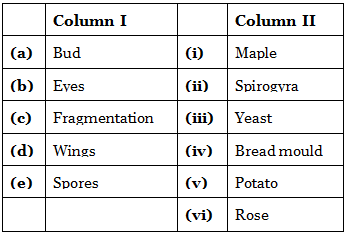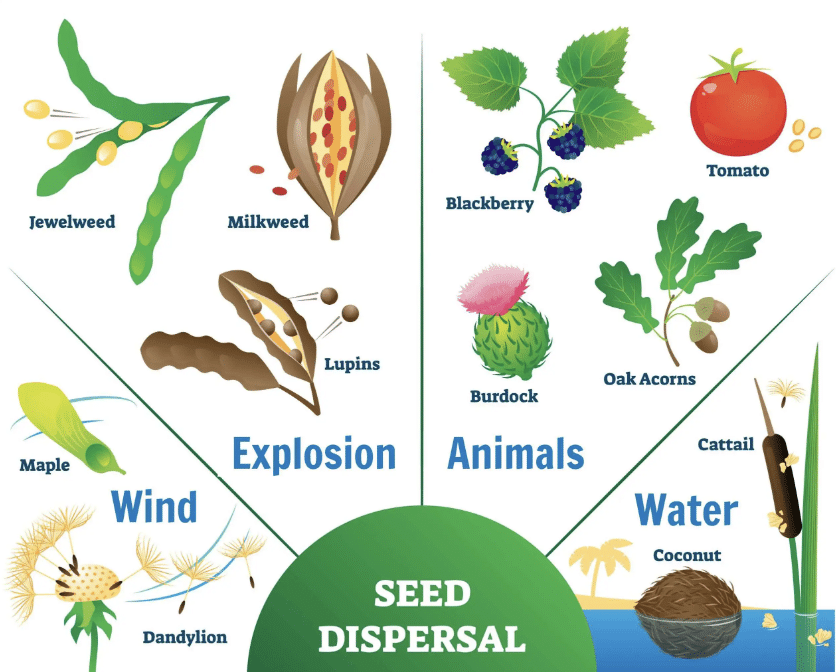NCERT Solutions for Class 7 Science - Reproduction in Plants
Q1. Fill in the blanks:
(a) Production of new individuals from the vegetative part of the parent is called _____________.
Ans: vegetative propagation.
 View Answer
View AnswerVegetative propagation is a type of asexual reproduction in plants, where new plants grow from non-reproductive plant parts, such as roots, stems, or leaves.
(b) A flower may have either male or female reproductive parts. Such a flower is called _____________.
Ans: unisexual.
 View Answer
View AnswerUnisexual plants have separate male and female reproductive structures.
(c) The transfer of pollen grains from the anther to the stigma of the same or another flower of the same kind is known as _____________.
Ans: pollination.
 View Answer
View AnswerPollination in plants is the process of transferring pollen from the male reproductive organ (stamen) to the female reproductive organ (pistil), allowing fertilization
(d) The fusion of male and female gametes is termed as _____________.
Ans: fertilization.
 View Answer
View AnswerFertilization in plants occurs when male reproductive cells (pollen) unite with female reproductive cells (ova), resulting in the formation of a new plant embryo within a seed.
(e) Seed dispersal takes place by means of _____________, _____________ and _____________.
Ans: wind, water and animals.
 View Answer
View AnswerSeed dispersal in plants is the process by which seeds are transported away from the parent plant. Various mechanisms, such as wind, water, animals, and self-propulsion, facilitate this movement of seeds.
Q2. Describe the different methods of asexual reproduction. Give examples.
Ans: The various modes of asexual reproduction in plants are as follows:
(i) Fission: Asexual reproduction through fission is a process where an organism splits into two or more separate individuals, each with the ability to grow and develop into a complete organism.
Example: Single-celled organisms like bacteria and some simple multicellular organisms like certain types of fungi.
(ii) Vegetative propagation: It is the ability of a plant to produce new plants from roots, stems, leaves, and buds.
Example: Potato, ginger. Potato Eyes
Potato Eyes
(iii) Budding: It involves the formation of a new individual from a bulb-like projection called a bud. The bud grows and detaches from the parent to form a new individual. It is commonly observed in yeast. (iv) Fragmentation: It is a form of asexual reproduction where a new organism is formed from the fragments of the parent body. It is the only mode of asexual reproduction in Spirogyra.
(iv) Fragmentation: It is a form of asexual reproduction where a new organism is formed from the fragments of the parent body. It is the only mode of asexual reproduction in Spirogyra. Fragmentation in Spirogyra
Fragmentation in Spirogyra
(v) Regeneration: Regeneration is the ability of an organism to regrow or replace lost or damaged body parts. It is a process by which new cells are produced to replace the lost or damaged ones.
(vi) Spore formation: Many non-flowering plants reproduce through spore formation. Spores are tiny cells protected by a thick wall. Fungi such as bread molds reproduce asexually using this method.
Q3. Explain what you understand by sexual reproduction.
Ans: The mode of reproduction in which two parents are involved in the production of a new organism is called sexual reproduction. It is found mainly in higher plants where the male gamete and female gamete fuse to form a zygote. These zygotes develop into individuals are not identical. Offsprings inherit the characteristics of both parents. In sexual reproduction, both parents survive after the process of reproduction.
Q4. State the main difference between asexual and sexual reproduction.
Ans: Differences between sexual and asexual reproduction:
Q5. Sketch the reproductive parts of a flower.
Ans: Male and Female Reproductive Parts of Flower
Male and Female Reproductive Parts of Flower
Q6. Explain the difference between self-pollination and cross-pollination.
Ans: Differences between self-pollination and cross-pollination:
- Self-pollination: Pollen grains transfer from the anther to the stigma of the same flower.
- Cross-pollination: Pollen grains move from the anther of one flower to the stigma of a different flower of the same species.
- Both processes are essential for plant reproduction and can be facilitated by wind, water, or insects.

Q.7. How does the process of fertilization take place in flowers?
Ans: When pollen grain lands on the stigma of the flower, it germinates and gives rise to a pollen tube that passes through the style and reaches the ovary of a pistil. When the pollen tube reaches an ovule, it releases the male gametes. A male gamete fuses with a female gamete in the ovule. This process is known as fertilization. The cell which is formed after the fusion of a male and a female gamete is known as a zygote. This zygote divides several times to form the embryo present inside the seed.

Q.8. Describe the various ways by which seeds are dispersed.
Ans: Seed dispersal occurs by the following agencies.
(i) Dispersal by animals: There are many ways by which birds and animals can disperse seeds.
- For example: birds and animals can eat the fruits and excrete the seeds away from the parent plant.
(ii) Dispersal by wind: Seeds that get dispersed by wind are usually smaller in size or they have wings or hair-like structures.
- For example: winged seeds of drumsticks, hairy fruit of sunflowers, etc. are dispersed by wind.

(iii) Dispersal by water: Many aquatic plants or plants that live near water have seeds that can float and are carried away by water.
- For example: coconuts can float and are dispersed by water.
(iv) Dispersal by explosion: Sometimes the seeds are dispersed by the bursting of fruits with sudden jerks. The seeds get scattered or distributed far from the parent plant.
- Examples of such plants are castor and balsam.
Q9. Match items in Column I with those in Column II:

Ans:

 View Answer
View Answer(a) Bud → (vi) Rose: Buds are the part of the plant that can give rise to a new plant, and roses can propagate by budding.
(b) Eyes → (v) Potato: Eyes are the buds of a potato, which are used for vegetative propagation in plants.
(c) Fragmentation → (ii) Spirogyra: Fragmentation is a type of asexual reproduction where the organism breaks into fragments, each capable of growing into a new individual. Spirogyra, a type of algae, reproduces by fragmentation.
(d) Wings → (i) Maple: Maple trees have winged seeds that are dispersed by wind.
(e) Spores → (iv) Bread mould: Spores are reproductive bodies in fungi like bread mould (Rhizopus), and they are responsible for its reproduction.
Q10. Tick (√ ) the correct answer:
(a) The reproductive part of a plant is the
(i) leaf
(ii) Stem
(iii) Root
(iv) Flower
Ans: (iv) flower
 View Answer
View AnswerThe flower is the reproductive part of a plants as they contain reproductive organs, such as stamens and pistils, which enable them to reproduce.
(b) The process of fusion of the male and female gametes is called
(i) Fertilisation
(ii) Pollination
(iii) Reproduction
(iv) Seed formation
Ans: (i) Fertilisation
 View Answer
View AnswerFertilisation is a crucial process in sexual reproduction that involves the fusion of male and female gametes, resulting in the formation of a zygote.
(c) Mature ovary forms the
(i) Seed
(ii) Stamen
(iii) Pistil
(iv) Fruit
Ans: (iv) Fruit
 View Answer
View AnswerThe mature ovary forms the fruit in a flowering plant. During the process of fertilization, the ovary develops and enlarges to protect and nurture the developing seeds. As the seeds mature, the ovary transforms into a fruit.
(d) A spore-producing plant is
(i) Rose
(ii) Bread mould
(iii) Potato
(iv) Ginger
Ans: (ii) Bread mould
 View Answer
View AnswerBread mould is a type of fungus that reproduces through spore production. These spores are tiny, lightweight, and easily dispersed through the air.
(e) Bryophyllum can reproduce by its
(i) Stem
(ii) leaves
(iii) Roots
(iv) Flower
Ans: (ii) leaves
 View Answer
View AnswerBryophyllum, a genus of succulent plants, has a unique ability to reproduce through its leaves. This process, known as vegetative reproduction.
|
112 videos|252 docs|28 tests
|
FAQs on NCERT Solutions for Class 7 Science - Reproduction in Plants
| 1. What are the different methods of asexual reproduction in plants? |  |
| 2. How does sexual reproduction in plants occur? |  |
| 3. What is the role of pollinators in plant reproduction? |  |
| 4. What are the advantages of asexual reproduction in plants? |  |
| 5. Can you explain the process of seed dispersal in plants? |  |



















